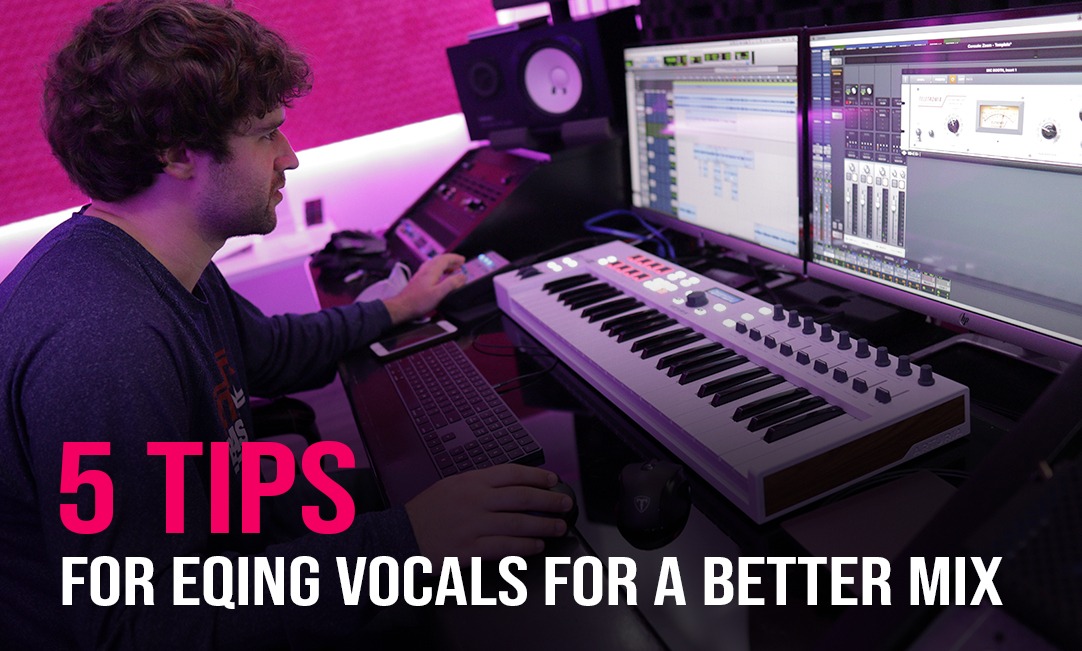5 Tips for Editing Vocals for a Better Mix

Vocals are one of the main components of any blend. That makes mixing them well a main pressing issue for all makers.
And keep in mind that pressure, send impacts, and legitimate altering is significant for decently strong, numerous novice and transitional blenders battling with how to EQ vocals for the best fit in the blend.
No two vocal accounts will require precisely the same EQ choices to work, yet there are a few fundamental strategies you can utilize on the off chance that you don't have any idea where to begin.
The following are 5 tips for EQing vocals for a superior blend:-
1. Decline boomy lows with a high-pass channel
It's normal during vocal following for vocalists to sing adequately close to the amplifier to present nearness impact It implies an expansion in low frequencies that occurs with some mouthpiece polar examples. The nearer you position a cardioid mouthpiece to the wellspring of a sound, the more low end is underlined in the sign. This can be a strong impact to make vocals sound thick, warm, and amazing. In any case, an excess of low end can cause sloppiness and dull sound that becomes mixed up in a blend. The principal EQ move many designers make is to set a high-pass channel to eliminate bass frequencies that aren't contributing emphatically to the sound. For me, this is ordinarily between 40-85 Hz. Higher frequencies might work for you, simply be mindful so as not to eliminate an excessive amount of warmth and authority fr om the lows. This procedure can likewise assist with diminishing thundering sounds fr om the artist moving situation around the mic.
2. Help the highs
Current vocal creation needs to take off over the blend in with modern top end. Indeed, even with a splendid receiver, you might have to support the high frequencies with EQ for the radiance and sparkle you want. This is a fragile undertaking since expanding the highs can present cruelty if you don't watch out. I by and large began with my smoothest sounding EQ module and investigation with supports between 8 kHz and 15 kHz. It pays to be delicate here since even a couple of dB at these frequencies can significantly impact an all-around brilliant sound. Try to ensure you're not incidentally helping them reach wh ere the vocalist's voice makes sibilance.
3. Utilize a de-esser
This method isn't stringently EQ, however, it influences the vocal's frequency balance so I'll incorporate it here. You might have seen as you blend that specific vocal sounds are more earnestly to control than others with EQ. The most widely recognized offender is sibilance or the unforgiving scratching sound that can occur for certain mouthpieces when the vocalist articulates an "S" syllable. De-essers decrease it by constricting the sign just in the reach wh ere the "S" sounds jump out most. Assuming that you want a more top to bottom manual for de-esser modules, we made a rundown of the best ones with tips on the most proficient method to utilize them. For most de-essers, you should simply choose the reach where the "S" sounds are generally hostile and choose the amount to decrease them with edge control.
4. Shape the mids
The midrange frequencies are the place where the majority of the symphonious and melodic sounds in your blend struggle. The midrange frequencies are the place where the vast majority of the symphonious and melodic sounds in your blend struggle. That makes it particularly difficult to deal with EQ for the best strong. Tragically there's no right response here with regards to vocals. Each blend is extraordinary and requires various decisions for the best outcome. All things considered, the following are a couple of normal EQ moves and the impact they produce to assist you with the beginning.
- Add warmth
Low midrange frequency lifts can help warm up a fragile vocal track. I now and then attempt limited supports between 250 Hz and 700 Hz assuming that the vocal track sounds excessively slight. This reach is frequently related to sloppiness, so helping a lot here can decrease definition. On the off chance that your vocal is as of now warm enough probably won't require it!
- Decline boxiness
A few vocal sounds contain so much midrange that they sound sifted and restricted. Many specialists utilize the expression "square-shaped" to portray this quality. To assist with lessening it you can scoop out some midrange somewhere in the range of 800 and 2.5 kHz with a wide Q channel. This can make the vocals sound more hey-fi and broadened, particularly assuming that you're helping the top of the line also.
5. Add immersion for the additional gleam
At long last, this last strategy isn't by and large EQ, however, it's an elective you might view as valuable for a few vocal sounds. A few vocal sounds contain so much midrange that they sound separated and slender. Many specialists utilize the expression "square-shaped" to portray this quality. Immersion in mixing is a melodic cut-out that adds drive and music to a sound. In outrageous settings, it borderlines into all-out twisting, yet that is not what I'm referring to here. For vocal mixing, immersion is typically delicate tone-forming that is intended to give vocals more presence in the blend. As you present the section with immersion modules, the upper midrange frequencies become more extravagant and more obvious on the general surface. On the off chance that straightforward EQ supports aren't giving you enough action around here, light immersion can bring it out in an interesting manner.
CONCLUSION
ZOOM Recording Studio is a well-equipped studio with the newest tools and skilled and talented editors and sound engineers that provide professional VOCAL MIXING recording studio services.